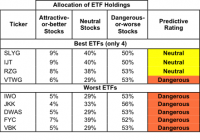How To Find The Best Style ETFs: Q2’15 In Review
Summary The large number of ETFs hurts investors more than it helps as too many options become paralyzing. Performance of an ETFs holdings are equal to the performance of an ETF. Our coverage of ETFs leverages the diligence we do on each stock by rating ETFs based on the aggregated ratings of their holdings. Finding the best ETFs is an increasingly difficult task in a world with so many to choose from. How can you pick with so many choices available? Don’t Trust ETF Labels There are at least 65 different All Cap Blend ETFs and at least 289 ETFs across twelve styles. Do investors need 20+ choices on average per style? How different can the ETFs be? Those 65 All Cap Blend ETFs are very different. With anywhere from 4 to 3775 holdings, many of these All Cap Blend ETFs have drastically different portfolios, creating drastically different investment implications. The same is true for the ETFs in any other style, as each offers a very different mix of good and bad stocks. Large Cap Value ranks first for stock selection. Small Cap Blend ranks last. Details on the Best & Worst ETFs in each style are here . A Recipe for Paralysis By Analysis We firmly believe ETFs for a given style should not all be that different. We think the large number of All Cap Blend (or any other) style ETFs hurts investors more than it helps because too many options can be paralyzing. It is simply not possible for the majority of investors to properly assess the quality of so many ETFs. Analyzing ETFs, done with the proper diligence, is far more difficult than analyzing stocks because it means analyzing all the stocks within each ETF. As stated above, that can be as many as 3775 stocks, and sometimes even more, for one ETF. Any investor worth his salt recognizes that analyzing the holdings of an ETF is critical to finding the best ETF. Figure 1 shows our top rated ETF for each style. Note there are no ETFs currently under coverage in the All Cap Growth or All Cap Value Styles. Figure 1: The Best ETF in Each Style Sources: New Constructs, LLC and company filings How to Avoid “The Danger Within” Why do you need to know the holdings of ETFs before you buy? You need to be sure you do not buy an ETF that might blow up. Buying an ETF without analyzing its holdings is like buying a stock without analyzing its business and finances. No matter how cheap, if it holds bad stocks, the ETF’s performance will be bad. PERFORMANCE OF ETF’S HOLDINGS = PERFORMANCE OF ETF If Only Investors Could Find Funds Rated by Their Holdings The Arrow QVM Equity Factor ETF (NYSEARCA: QVM ) is the top-rated Large Cap Blend ETF and the overall best ETF of the 289 style ETFs that we cover. The worst ETF in Figure 1 is the SPDR S&P 600 Small Cap Growth ETF (NYSEARCA: SLYG ), which gets our Neutral rating. One would think ETF providers could do better for this style. Disclosure: David Trainer and Max Lee receive no compensation to write about any specific stock, style, or theme. Disclosure: I/we have no positions in any stocks mentioned, and no plans to initiate any positions within the next 72 hours. (More…) I wrote this article myself, and it expresses my own opinions. I am not receiving compensation for it. I have no business relationship with any company whose stock is mentioned in this article.


